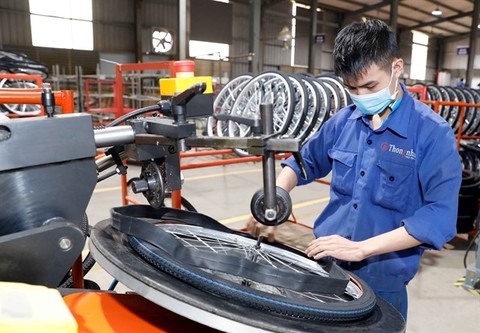
Bikes produced at Thống Nhất Company. The Vietnamese economy is expected to grow at a solid pace this year and the next, despite a challenging global environment. — VNA/VNS Photo Trần Việt
The Vietnamese economy is expected to grow at 6 per cent in 2024 and 6.2 per cent in 2025 on fiscal policies and sizeable public investment, according to the Asia Development Outlook April released by the Asian Development Bank (ADB) on Thursday.
Despite lingering uncertainties in the external environment, the ADB maintained its earlier growth projection for Việt Nam, pointing out that a relatively broad-based restoration in export-led manufacturing and services, as well as stable performance of the agriculture sector are expected to support the recovery momentum.
“Positive inflows of foreign direct investment (FDI) and remittances, a sustained trade surplus, recoveries in domestic consumption, and continued fiscal stimulus characterised by substantial public investment are seen as key to boosting growth in 2024,” the report wrote.
Inflation will edge up at 4 per cent for 2024 and 2025 in tandem with the economic revival.
“Việt Nam’s economy is expected to grow at a solid pace this year and the next, despite a challenging global environment,” said ADB Country Director for Việt Nam Shantanu Chakraborty.
If these growth rates are achieved, Việt Nam will be among the fastest growing economies in the region, he said.
“However, global geopolitical uncertainties and domestic structural fragilities could impact the outlook. Therefore, policy measures in 2024 will need to combine short-term growth support measures to strengthen domestic demand with long-term structural remedies to promote sustainable growth.”
Key for growth
Limited monetary policy space, fiscal and investment spending will be key for growth in 2024, said Nguyễn Bá Hùng, Principal Country Economist.
“A comfortable fiscal position with a mild budget deficit and a low public debt-to-GDP ratio provides sufficient fiscal space to support growth.”
He pointed out that the ongoing value-added tax reduction program was extended until June 2024 and could be extended further to the end of 2024.
A sizeable amount of public investment, equivalent to US$27.3 billion, has been programmed for disbursement this year. Together with disbursements from 2023, this additional public investment would significantly stimulate growth.
A gradual revival of export-led manufacturing would support FDI. Registered FDI increased by 13.4%, and disbursed FDI went up 7.1 per cent in the first quarter of 2024 compared with the same period last year. Accelerated public investment and improved business conditions can spur private investment in 2024.
As softened global demand caused by a slow economic recovery and delayed normalisation of interest rates in the US and other advanced economies, coupled with continued geopolitical tensions, are likely to hamper a full recovery of Việt Nam’s export-led growth, fiscal measures for supporting growth and public investment would ultimately become the key policy options to reignite growth.
To accelerate growth, stronger measures are required to address domestic structural fragilities, such as heavy reliance on FDI-led manufacturing exports, weak linkages between manufacturing export industries and the rest of the economy, incipient capital markets, an overreliance on bank credit, and complex regulatory barriers to business, he said.
Hùng pointed out that a key policy challenge is enhancing public investment effectiveness for short-term stimulus and as a foundation for longer – term development.
He said public investment remains a catalyst for Việt Nam’s economic growth, so its effective implementation is crucial.
According to the Ministry of Planning and Investment, an increase of 1 per cent in public investment disbursement corresponds to a 0.058 per cent increase in GDP growth. In addition, every 1 đồng of disbursed public investment capital stimulates 1.61 đồng of investment capital from the non-state sector.
However, the execution rate compared to planned investment has been consistently low, hovering around 80 per cent for the year. While the government has tried to address this problem, progress has been insufficient.
More systematic measures are required to improve legal and regulatory processes and so reduce constraints on efficient delivery, Hùng said. “Better readiness to expedite project implementation will help minimise cost overruns.”
The report pointed out that one major obstacle to timely and quality project preparation is the complexity of regulations, particularly land use planning, land acquisition and site clearance. Soaring prices due to shortages of materials and inputs for production, driven by regulatory constraints, lead to higher costs, forcing contract renegotiations or the need for additional funding and approvals.
As part of improving project cycle procedures, regulations should be revised to allow for principle-based flexibility and fit-for-purpose adjustments, the report wrote, adding that this will help facilitate efficient project approval and management that can be adapted to various circumstances without repeating the approval process.
By proactively addressing these obstacles in an integrated manner throughout the project cycle, Việt Nam can unlock the full potential of its public investment initiatives, driving sustainable economic growth and development, according to the report.
The Vietnamese economy contracted to 5 per cent in 2023 from 8 per cent in 2022, missing the Government’s goal of 6-5.6 per cent but still positive in the context of global slowdown. — VNS